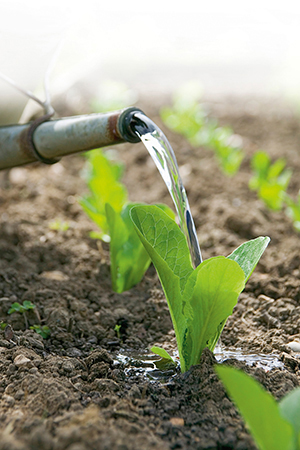
Water young plants carefully so they don’t lose their foothold.
Regular watering—not too much, not too little—is important for all plants. Collecting rainwater in a barrel or tank for use during dry spells is a long-standing practice that is just as useful today, even if your garden is small.
Collecting rainwater is not only an environmentally friendly practice, it is better for plants than using tap water, which may contain small traces of chlorine.
Look at a plant’s leaves to see how much water to give.
• Small, leathery, thorny, shiny or fleshy leaves indicate a low need for water, as do leaves with a wax-like layer. Succulents or Mediterranean plants do well without a lot of water, as do ivy, amaranth, nasturtium, sage, French marigolds and zinnia.
• Plants with soft, large or thin leaves tend to be thirsty, as do all flowering plants and those with solid rootballs and shallow root systems.

Water young plants carefully so they don’t lose their foothold.
A SOAKER HOSE RELEASES WATER slowly but STEADILY.
• Water plants in both the flower and vegetable gardens before 9:30 a.m. The leaves will dry off quickly, reducing the risk of a fungal infection. If you water plants at night in cool weather, the soil surrounding them remains wet, potentially causing the roots to rot—plus, the moisture could attract snails. But evening watering is highly recommended in hot weather as it reduces evaporation.
• Water infrequently but thoroughly. The pauses between watering leave time for a deeper, branching root system to form in the drier soil. Don’t saturate plants in heavy soil—they will become waterlogged.
• Make an inexpensive soaker hose at home from an old garden hose. Drill some small holes into it, connect it to the main hose and you’ve got an effective, efficient watering system.
• Be particularly careful not to water the leaves of melons, peppers or tomatoes. If you have time, it’s even worth shaking rainwater from their leaves to be sure fungal diseases don’t set in.
• Don’t water directly on flowers. In the sunlight, the little water droplets act like a magnifying glass, potentially burning delicate petals.
• During hot summer weather just spray the plants—but don’t do it in bright sunshine.
• Young shoots need more water than plants that are several years old with deep root systems.
• Water thirsty plants at ground level so that maximum water gets to the roots.
• If you water intensively with a watering can every couple of days in the summer heat, repeat the process after about 30 minutes. The water will penetrate deeper into the soil.
• Water bushes and shrubs on the root area beneath the outer branches. During dry periods, large trees need plenty of water, especially fruit trees when they are flowering or when fruit is ripening. Water for several hours.
• Always water plants well before you move them, and again after they are in their new positions.
Watering aids
one Dig a hole about 6 inches (15 cm) deep next to a plant that needs lots of water.
two Place a flowerpot of the correct size into the hole, drain hole downwards, and cover it with a plate or piece of plastic. Disguise it with leaves or a little soil.
three Fill with water at regular intervals. It will trickle slowly into the earth and reach the roots directly.
Most plants tolerate rainwater better than water from a spring or tap. Collected rainwater is usually warmer and free of fluoride, chlorine and lime. Water that is high in lime, leaves white spots on the leaves.
• Keep water clear by occasionally adding a little charcoal or activated carbon (for use in aquariums) to the rain barrel.
• Cover barrels so that small animals can’t get in.
• Collect the water in which vegetables have been cooked—which contains nutrients—for use in the garden.
Connect a rain barrel directly to the downpipe of the roof gutter. If the barrel is raised, it’s easier to fill the watering can.
• Rake the soil regularly, including in the furrows. Loosening the soil gives water easier access to a plant’s roots.
• After a heavy summer rain, loosen up the soil only on the surface or the moisture in it will evaporate too quickly.
• Spread a layer of mulch to hold the moisture in the soil longer and prevent plants from getting thirsty too quickly.